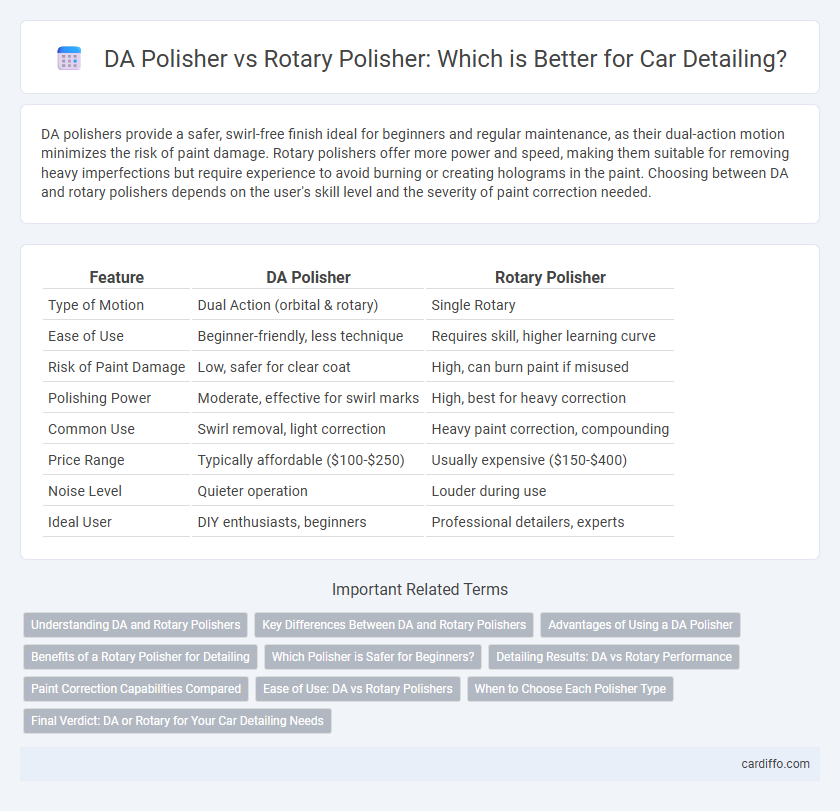DA polishers provide a safer, swirl-free finish ideal for beginners and regular maintenance, as their dual-action motion minimizes the risk of paint damage. Rotary polishers offer more power and speed, making them suitable for removing heavy imperfections but require experience to avoid burning or creating holograms in the paint. Choosing between DA and rotary polishers depends on the user's skill level and the severity of paint correction needed.
Table of Comparison
| Feature | DA Polisher | Rotary Polisher |
|---|---|---|
| Type of Motion | Dual Action (orbital & rotary) | Single Rotary |
| Ease of Use | Beginner-friendly, less technique | Requires skill, higher learning curve |
| Risk of Paint Damage | Low, safer for clear coat | High, can burn paint if misused |
| Polishing Power | Moderate, effective for swirl marks | High, best for heavy correction |
| Common Use | Swirl removal, light correction | Heavy paint correction, compounding |
| Price Range | Typically affordable ($100-$250) | Usually expensive ($150-$400) |
| Noise Level | Quieter operation | Louder during use |
| Ideal User | DIY enthusiasts, beginners | Professional detailers, experts |
Understanding DA and Rotary Polishers
Dual Action (DA) polishers use an oscillating motion combined with rotation, minimizing heat buildup and reducing the risk of paint damage, making them ideal for beginners and safe for most paint types. Rotary polishers rotate in a single direction at high speeds, offering more aggressive cutting power for correcting severe paint defects but requiring more skill to avoid swirl marks and burn-through. Understanding these operational differences helps detailers choose the right tool for specific polishing tasks, balancing efficiency and paint protection.
Key Differences Between DA and Rotary Polishers
DA polishers feature an orbiting motion ideal for beginners and paint correction with less heat buildup, while rotary polishers use a direct spinning motion suited for advanced users and heavy defect removal. The dual-action (DA) design reduces the risk of paint damage and swirl marks, making it safer on delicate surfaces. Rotary polishers provide higher cutting power and faster correction but require skill to avoid burns or holograms on automotive paint.
Advantages of Using a DA Polisher
A DA polisher offers enhanced versatility by combining dual-action rotation and oscillation, significantly reducing the risk of paint burns and swirl marks compared to rotary polishers. Its user-friendly design enables better control for beginners and professionals, ensuring consistent polishing results without causing excessive heat buildup on the vehicle's surface. This tool is ideal for safely refining paintwork, removing light imperfections, and applying wax or sealants with minimal effort.
Benefits of a Rotary Polisher for Detailing
A rotary polisher delivers superior cutting power compared to a dual-action (DA) polisher, making it highly effective for removing severe paint defects such as deep scratches and oxidation. Its consistent speed and orbital motion allow professional detailers to achieve a high-gloss, swirl-free finish on automotive paint surfaces. The precision and control of a rotary polisher enable accelerated correction times and enhanced polishing results in automotive detailing workflows.
Which Polisher is Safer for Beginners?
A Dual Action (DA) Polisher is safer for beginners due to its user-friendly design that minimizes the risk of paint damage by combining rotational and orbital movements, reducing heat buildup and swirl marks. In contrast, a Rotary Polisher spins in a single, consistent direction at high speeds, increasing the likelihood of burning the paint if not carefully controlled. Beginners benefit from the DA Polisher's forgiving operation, making it the recommended choice for initial polishing tasks.
Detailing Results: DA vs Rotary Performance
DA polishers deliver more consistent and swirl-free finishes, making them ideal for beginners aiming for high-quality detailing results. Rotary polishers generate higher heat and cut aggressively, offering faster correction but increasing the risk of paint damage if not used expertly. Understanding the performance differences helps detailers choose the right tool for precise paint correction and optimal surface restoration.
Paint Correction Capabilities Compared
DA polishers offer superior paint correction by minimizing the risk of swirl marks and holograms due to their dual action motion, making them ideal for beginners and moderate imperfections. Rotary polishers provide more aggressive cutting power and faster correction of deep scratches and oxidation but require advanced skill to avoid paint damage. Both tools can achieve professional results, yet rotary polishers excel in heavy-duty paint correction while DA polishers prioritize safety and ease of use.
Ease of Use: DA vs Rotary Polishers
Dual Action (DA) polishers offer superior ease of use compared to rotary polishers due to their oscillating motion, which reduces the risk of paint damage and user fatigue. DA polishers require less skill for effective results, making them ideal for beginners and hobbyists in automotive detailing. Rotary polishers demand more experience and control to avoid swirl marks and burns, making them less user-friendly for novice detailers.
When to Choose Each Polisher Type
DA polishers offer a safer option for beginners or delicate surfaces, minimizing the risk of paint burns and swirl marks during detailing. Rotary polishers deliver more aggressive cutting power, ideal for correcting deep scratches or heavy oxidation on resilient paint types. Choosing between the two depends largely on the vehicle's paint condition and the detailer's skill level, with DA polishers suited for maintenance and rotary polishers for restoration.
Final Verdict: DA or Rotary for Your Car Detailing Needs
DA polishers provide a safer and more user-friendly option for car detailing, reducing the risk of paint damage while delivering effective swirl removal and paint correction. Rotary polishers offer aggressive cutting power ideal for experienced users seeking to tackle deep scratches and severe oxidation but require advanced skill to avoid burning or holograms. For most enthusiasts and professionals aiming for balanced results with minimal risk, a DA polisher is the optimal choice for maintaining and enhancing automotive paint finishes.
DA Polisher vs Rotary Polisher Infographic

 cardiffo.com
cardiffo.com